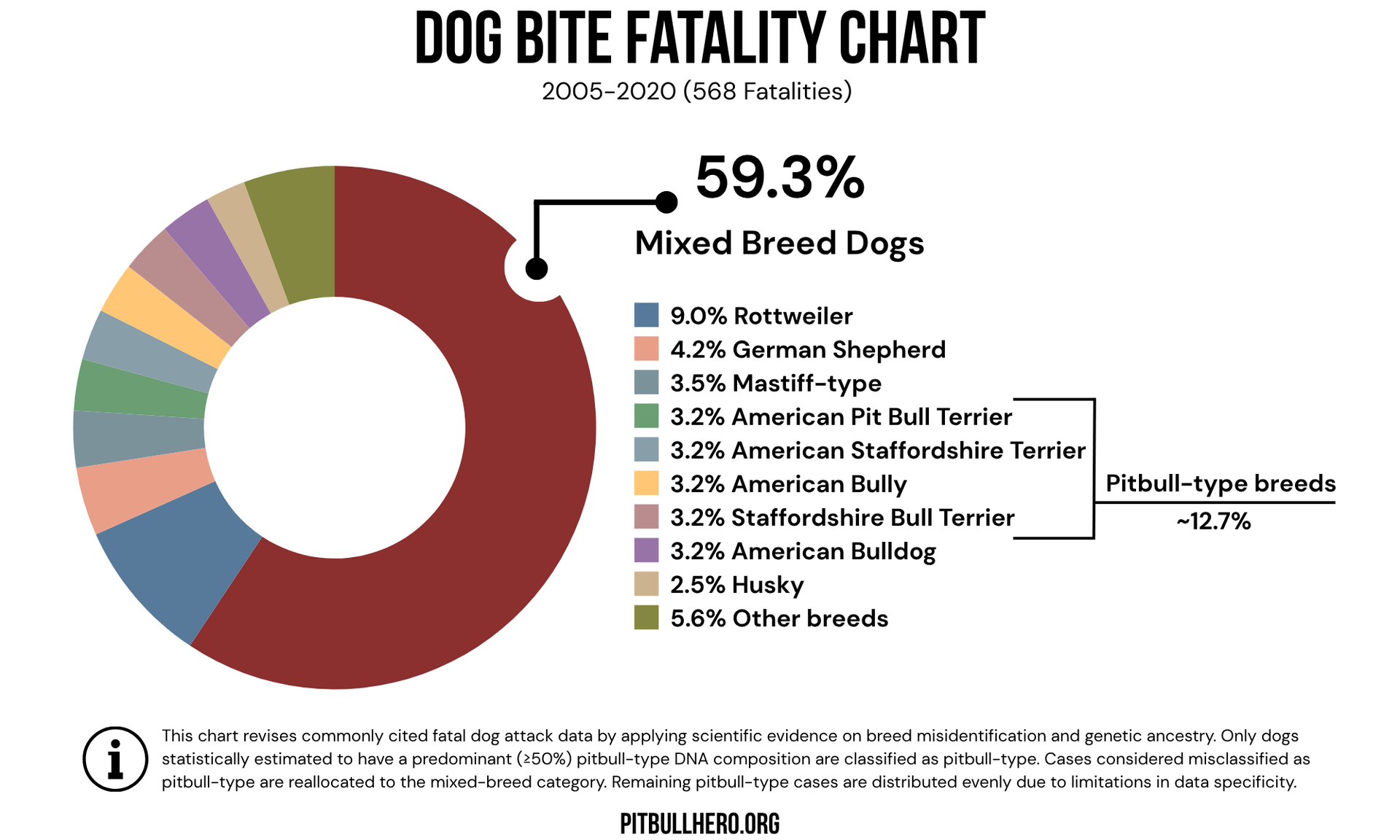Correcting Flawed Pitbull Statistics

Comprehensive studies on canine DNA and visual breed identification have found that, on average, 60% of dogs labeled as "pitbulls" have no genetic ancestry from pitbull-type breeds. This discrepancy results in inaccurate breed information in media reports and unreliable data in dog bite and attack statistics. Additionally, among dogs with pitbull-type ancestry, the majority are mixed breed rather than predominantly pitbull.
As a result, commonly cited fatal dog attack statistics — often used by non-scientific sources and special interest groups to justify breed-specific legislation (BSL) — quickly fall apart when examined through the lens of DNA evidence.
What do corrected statistics reveal?
Flawed Statistics
Unreliable claims that pitbulls are responsible for the majority of fatal dog attacks (~66%) often stem from commonly cited but flawed statistics that arbitrarily group multiple pitbull-type breeds, more than 20 bully-type breeds, and various mixed breeds misidentified as pitbulls based on appearance. This invalid categorization inflates the numbers and distorts the data. However, studies show that most dogs visually labeled as "pitbulls" lack any DNA from pitbull-type ancestry — and among those that do, over half have less than 50%, classifying them as mixed-breed dogs. These findings reveal major flaws in dog bite statistics, medical research on dog bites, and justifications for BSL that rely on these flawed numbers.
Studies on the DNA of Dogs Labeled as "Pitbulls" Have Found
- 60% are misidentified: On average, 60% of dogs visually identified as "pitbulls" are misidentified — lacking any DNA from pitbull-type ancestry.
- 53% are mixed breed dogs: Among dogs with pitbull-type ancestry, 53% have less than 50% pitbull-type DNA — and are therefore classified as mixed-breed dogs, not "pitbull mixes," by standard genetic definitions.
Sources: The Veterinary JournaL (2015) | PLOS ONE (2018)
66% ➡︎ 26%
When accounting for the fact that 60% of dogs identified as "pitbulls" lack DNA from pitbull-type ancestry, the flawed 66% statistic is reduced by more than half to ~26%.
[66%×0.40=~26%]
26% ➡︎ 12%
When accounting for the fact that, among dogs with pitbull-type ancestry, 53% have less than 50% pitbull-type DNA — and are therefore,
by definition, mixed-breed dogs — the 26% statistic is further reduced by more than half to ~12%.
[26%×0.47=~12%]
Corrected DNA-Based Statistics
This dog bite fatality chart revises commonly cited fatal dog attack data by applying scientific evidence on breed misidentification and genetic ancestry. Only dogs statistically estimated to have a predominant (≥50%) pitbull-type DNA composition are classified as such. Cases considered misclassified are reallocated to the mixed-breed category. Remaining pitbull-type cases are distributed evenly due to limitations in data specificity. As the most popular dog type in the U.S., pitbulls are underrepresented in fatality statistics, accounting for ~12.7% of fatalities despite comprising ~20% of the dog population.

A Better Way Forward
Scientific evidence strongly discredits many commonly cited — but questionable and unscientific — dog bite and attack statistics, along with the core assumptions behind BSL. Yet, special interest groups continue trying to justify these misguided laws by stigmatizing pitbulls with flawed or exaggerated data. However, when these statistics are corrected using DNA-based research, the justification for BSL quickly falls apart.
It's worth noting that both sides of the debate share the same goal: reducing dog bites and protecting the public. The difference is that only one approach — breed-neutral policies focused on behavior and responsible ownership — is supported by science, expert consensus, and real-world results.
For public safety policy to be effective and equitable, it must reflect what DNA research and numerous studies have shown: breed is not an accurate predictor of aggression; visual identification is unreliable; and responsible ownership, training, and supervision are the true keys to prevention.
Rather than punishing responsible owners and well-behaved dogs based on breed assumptions or flawed statistics, communities should adopt behavior-based, breed-neutral laws that promote safety, accountability, and fairness — for all dogs and all people.

